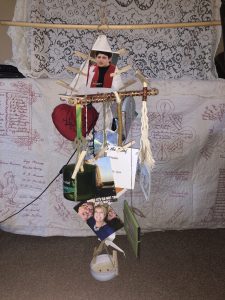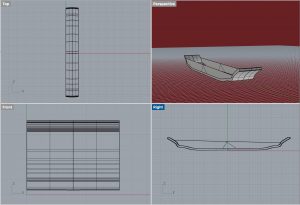13 Megan Plunkett on John Cage
Megan (she/her) is a junior in the University of Washington Honors Program. She is studying Information Sciences, and would like to venture into the realm of user experience and interface design. Doing this, she hoped to bridge the disparity gaps that arise as a result of technological advancement. Personally, Megan illustrates in her free time, raises plants, and takes the occasional trip to The Container Store.
Megan has chosen to analyze John Cage for her final project in HONORS 211. John Cage, a pioneer of the 20th century, led other artists as a teacher at the Black Mountain College, mastered the concept of “prepared piano”, and one of the greatest avant-garde composers of the 20th century. In her analysis and letter, Megan will question Cage on the preservation of sound and time, the line between defying musical norms and “no rules”, will compare Cage’s work to her studies in the HONORS 211 course, and more.
Preface (course overview, letter overview, and clarification)
In the HONORS 211 course, I was challenged in ways I never expected. My initial idea for our first project (“Waiting”) was to provide a concrete example of what I do when I wait. This idea was quickly challenged, as our professor Timea informed me that it was not representative of waiting in its truest form. My idea was constructed, broad, and lacking of authenticity and depth. The truth of it was… Timea had found my secret: I am a creative and artist with an unfortunately powerful right-brain that keeps me from being impulsive. After being in a course for a mere few weeks, I was stripped to my core. I then took what I had learned and created a baby’s mobile- free of thought, mundanity, and monotony.
I thought of John Cage- his balance of bending norms while keeping a certain level of logic. When asked who I wanted to analyze and write to in a letter, I already knew.
In my letter, I hope to address my shortcomings in both my “Waiting” Project and CAD Project, ask Cage about his own experience with balancing logic, norms, and authentic creativity, and lastly look at him through the lens of any modern artist. Where does Cage stand in relation to them?


Letter
Dear John (Mr. Cage),
Foreword:
Though this letter is for a class, it is a true representation of what I would write to you. Every question and every opinion is with 100% curiosity and authenticity.
Hi. My name is Megan Plunkett and I am a student at the University of Washington. I first heard your piece “4’33”” while in a musicianship course in high school. Unfortunately, I failed the test, and had very little to write about it in my music journal. I talked about how it was silent, confusing, and that perhaps the thoughts in my very own mind about its emptiness were the true meaning of the piece. Retrospectively, this is a quite selfish thought. I never once contemplated that, perhaps, the sounds around me are what I should be listening to- the sniffles and shuffles of my classmates or the clicking of my professor’s computer keys…”. For that, I apologize and hope that I can prove my interest by showing you my research on your work, and comparing it to pieces I have done over the course of this quarter. There are two- the “Waiting” project and the CAD project. I find there are many overlaps in theme between the two assignments and some of your pieces. I will delve into that soon. Lastly, I wanted to share that I will leave some parts of this letter open-ended, as I wanted to get your thoughts on a couple art-related topics and opinions of modern day musicians.
My main questions at hand (for later reference are):
- Part 1: You are known for your impeccable manipulation of objects and instruments. However, you simultaneously search to find the “spirit” of objects and, in a way, preserve a part of them and their purpose. Where do you draw the line at preserving, while manipulating instruments’ and objects’ functions? How can you justify finding a “spirit” or connection between object and sound, while deconstructing its natural sound? How do you maintain the memory of their origin?
- Part 2: I took part in a CAD project, where I created a container using computer program software. Though sometimes I felt creative, other times, I felt like a cog in a wheel. How do you draw the line between inspiration from others and authenticity?
- Part 3: Modern music prides itself in being a shared experience between the artist and the audience. I’m sure this is something you can understand from your own works. However, is the predictability what makes it authentic or are modern artists diving too far into societal norms?
Part 1: “Waiting”, Preservation, and Manipulation
I would like to begin by addressing our “Waiting Project”. For this assignment, we were tasked with finding our own interpretation of waiting. What does it feel like? How can you represent this through art?
While in the process of deciding what to do for the project, I was helping my dad move house. The move was quite symbolic, as we had to clean out objects from my childhood and part way with the home I lived in from birth until I graduated high school. This house was lived in by 5 people. My growth was marked on the inside of my closet and my siblings’ and I’s bedrooms had layers of paint- documenting the phases we grew through as we formed out beings. For the project, I decided to construct a child’s mobile, using objects from my childhood as a means of preserving objects that were “waiting for me” to reuse them. I too was waiting- to peacefully depart with a house and a life while I travel into more formative years. A highlight of this assignment for me was creating a preservation of time.
I noticed this is also a common theme in your work. In the book Through The Looking Glass: John Cage and Avant-Garde Film, author Richard H. Brown says, “Cage turned to a primitive, perhaps regressive, technological approach to the “spirit inside objects” through the simple kinetic–mechanical act of percussion” (Brown 2019). Herein lies the fundamental connection between my project and your work: I took objects of a certain use (e.g. candles for burning, twine for picture hanging, etc.) and repurposed them, while simultaneously preserving their memory. My old objects became a mobile, which brings my childhood full circle, and the mobile now hangs in my dad’s music room. You too take objects and manipulate their original purpose to create art. The most classic example of yours that comes to mind is “Sonatas and Interludes”, where nuts and bolt were so meticulously placed into parts of a classical piano (Hawley 2019).
Again, you too took the purpose of both the piano, and the object manipulating it, and changed both of their purposes. I find myself curious, because I used my old objects to create a new symbolic object, whereas you took old objects/objects of another function, and made an intangible concept and brought it to the present. This is where we begin to differ. I guess I’m wondering how you balance the idea of preserving an object’s spirit while changing its purpose to create something so… non-lasting?
Part 2: CAD, Authenticity, Objects and Sounds
I also did a computer-aided design (CAD) project where I used 3D printing software to build myself a gondola, full of objects that I would put into a time capsule. To summarize, I chose art (for its everlasting quality), flowers (for its mortality but eternal beauty), and magazine (for a positioning of our time). I put a lot of thought into my project, but still struggled with the idea that I was using someone else’s system. How organic can my work be if someone built this computer and built this software and built the program I used (Rhino) and named the program functions I am clicking on? Where does it stop being contrived and start being authentic? Where does it stop being not just freedom to create, but a true masterpiece of your own work? I know you became an assistant to Oskar Fischinger, and that he was the inspiration behind you taking objects, finding their spirit, and setting them amongst other tools to explore their spectrum of sound. You studied the relationship between objects and sounds. My question to you regarding this is: How do you balance this inspiration and authenticity? You are known to have paved the way for other artists, but are also outspoken in your inspiration from people like Arnold Schoenberg and Oskar Fischinger (Cage, 1990). Your work is that of soul-searching, norm-bending, and yet you admit inspiration for other artists that are, arguably, similar to you in style.
Part 3: Modernizing, Predicting, and Experiencing
My last inquiry for you has to do with modern music. The top-charting music (especially pop) are known for having semi-predictable lyrics, chord progressions, and stories shareable with audiences. “The four chords”, as you know, crosses over several modern genres (e.g. pop, country, and hip-hop) to provide modern audiences with an easy listening experience. Even artists like Ed Sheeran, known for creativity and fluidity between the pop and alternate genres, often uses the four chords to attract listeners. He then reels them in further with his lyrics, diversity in tempo, timbre, etc. Despite “the four chords” making listeners’ experiences perhaps less anxiety-inducing , I wonder if creatives like you find it frustrating, because these pieces feel like a copy, or an inauthentic or overtold story.
Do you find that modern musicians are sticking to social norms and that the real creativity comes from interpretations and experiences of listening? Or does modern music bend too much, in your opinion, to societal norms, making it lose authenticity?
Conclusion:
To say I am a fan of your work is a gross understatement. I have enjoyed posing these questions to you as a listener, a fan, an admirer, and wonderer. You have paved the way for artists, musicians, thinkers, writers, philosophers, and I hope you know your impact is boundless.
Thank you!
Megan
Works Cited
1. Brown, Richard H. “The Spirit Inside Each Object.” Through The Looking Glass: John Cage and Avant-Garde Film. Oxford UP, 2019. Print.
2. Cage, John. “John Cage: An Autobiographical Statement.” Johncage.org. Web.
3. Hawley, Rachel. “How Composer John Cage Transformed the Piano—With the Help of Some Household Objects.” Smithsonian Magazine 24 Sept. 2019. Print.
4. Inaraferr. “John Cage – Sonata V (from Sonatas and Interludes) – Inara Ferreira, Prepared Piano.”YouTube. YouTube, 31 Aug. 2012. Web. 14 Mar. 2021.
5. Long, Nick. “Four Chords and the Truth.” Musical U. 29 Jan. 2020. Web. 18 Mar. 2021.
Media Attributions
- “Waiting” © Megan Plunkett
- “Time Capsule” © Megan Plunkett

